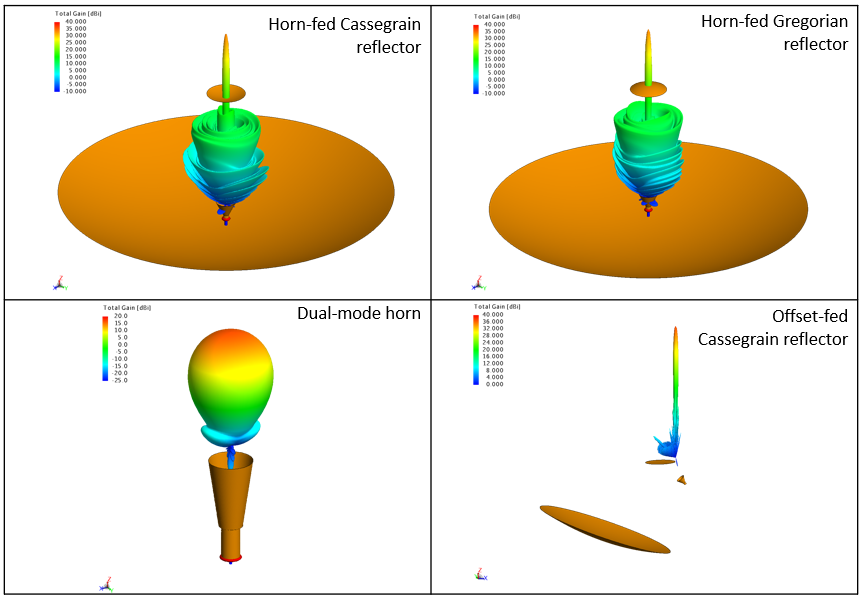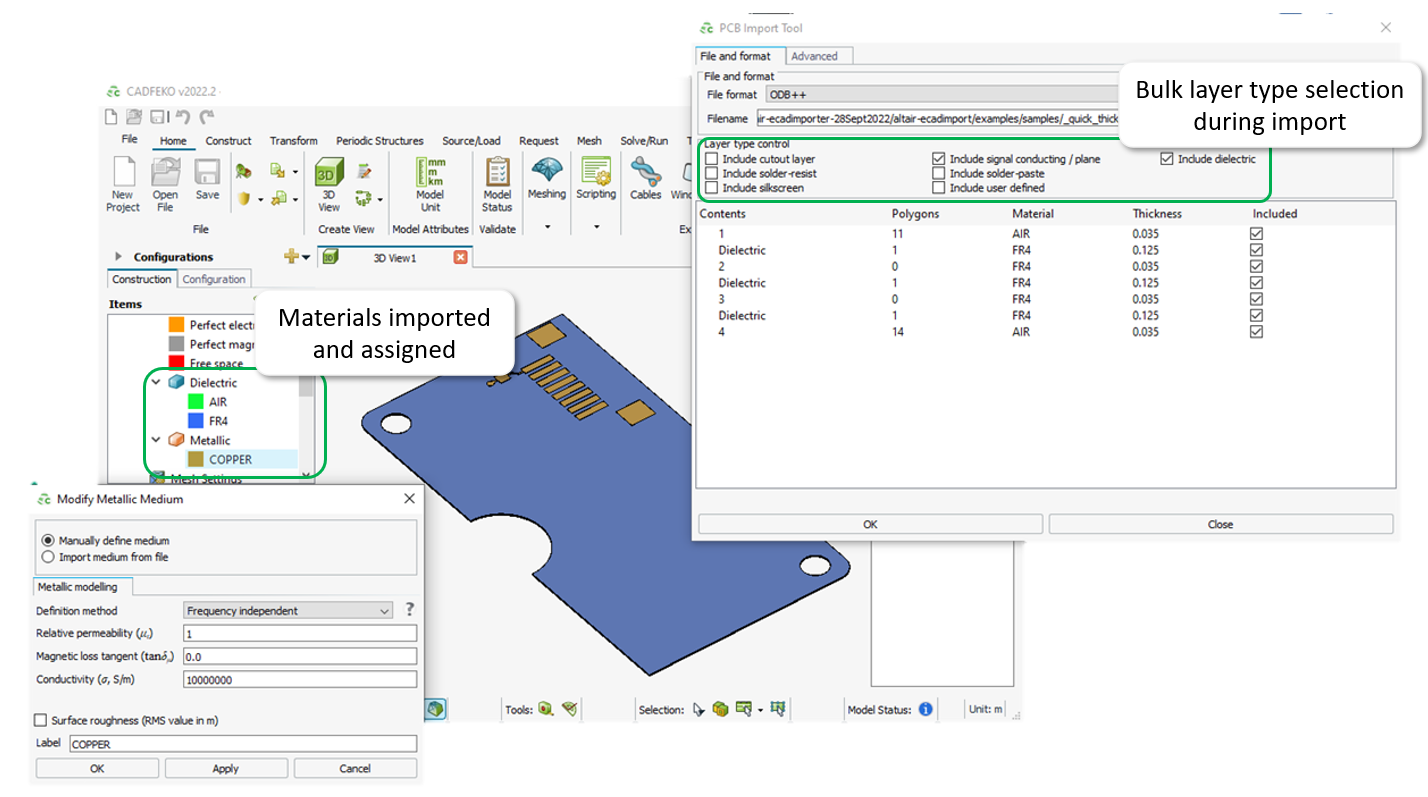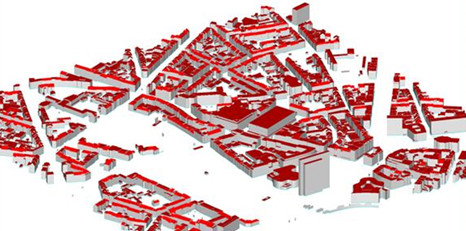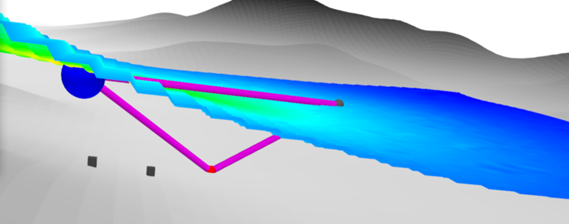Release Notes: Altair Feko 2022.2
Altair Feko 2022.2 is available with new features, corrections and improvements. It can be applied as an upgrade to an existing 2022.1 installation, or it can be installed without first installing Altair Feko 2022.1.
Feko is a powerful and comprehensive 3D simulation package intended for the analysis of a wide range of electromagnetic radiation and scattering problems. Applications include antenna design, antenna placement, microstrip antennas and circuits, dielectric media, scattering analysis, electromagnetic compatibility studies including cable harness modelling and many more.
newFASANT complements Altair’s high frequency electromagnetic software tool (Altair Feko) for general 3D EM field calculations, including, among others, special design tools tailored for specific applications like complex radomes including FSS, automated design of reflectarrays and ultra-conformed reflector antennas, analysis of Doppler effects, ultrasound systems including automotive or complex RCS, and antenna placement problems. Advanced solver technologies like the MoM combined with the characteristic basis functions (CBFS), PO/GO/PTD, GTD/PO and MLFMM parallelised through MPI/OpenMP, being some of them especially efficient for the analysis of electrically very large problems.
WinProp is the most complete suite of tools in the domain of wireless propagation and radio network planning. With applications ranging from satellite to terrestrial, from rural via urban to indoor radio links, WinProp’s innovative wave propagation models combine accuracy with short computation times.
WRAP is a comprehensive tool for electromagnetic propagation, antenna collocation and spectrum management. WRAP combines propagation analysis, often over large areas with many transmitters and receivers, with system analysis to include complex non-linear equipment properties.
Highlights of the 2022.2 Release
The most notable extensions and improvements to Feko, newFASANT, WinProp and WRAP in the 2022.2 release.
Salient Features in Feko
- A new Periodic Structures extension has been added to CADFEKO. This extension supports the preparation of structures such
as those used in frequency selective surface (FSS) simulations. The new shapes, geometry
and unit-cell tool can be used to quickly define both simple and complex parametric
multi-layer unit-cell representations of multi-layer dielectric structures which may
include FSS layers for material characterisation using a periodic boundary condition
approach. Characterised materials can in turn be applied to surfaces for efficient
simulation using RL/GO methods. With Feko 2022.2 it is also possible to apply such
characterised materials to surfaces bounding a closed region and solve using the
MoM/MLFMM. This provides an extremely powerful, flexible and efficient approach to
applications such as radome analysis.
Figure 1. A streamlined and flexible workflow for simulation of multi-layer FSS radome structures using material characterisation with PBC and MoM/MLFMM. 
- The waveguide port and sources were extended and can now also be applied to a single flat face on the boundary of a FEM region in CADFEKO in the same way as is done for SEP. This simplifies the process of switching between SEP and FEM for models using waveguide ports. Waveguide ports now support an additional power-based definition of magnitude which is common to all mode types and may be more intuitive.
- S-Parameter configurations in CADFEKO may now include additional requests (such as far field, near field and current requests) and seperate configuration/s are not needed. These quantities will be computed as part of the solution for each port that is active during the S-Parameter simulation.
- Four new components were added to the Component Library. These are
horn-fed reflector antennas as well as a dual-mode horn which may be used to provide more
uniform illumination of a reflector than would be achieved with a simple conical horn.
Figure 2. The four new components added to the Component Library. 
- The ray search process in the faceted UTD has been accelerated significantly. In isolated cases assumptions may result in small errors and an option is available to deactivate this acceleration feature should this impact on the accuracy of a specific solution.
- PCB Import in CADFEKO now supports material properties
that may be included in the imported PCB layout or ECAD data. The relevant materials will
be created and applied during the import process. Additional layer types (such as
solder-resist, solder-paste, silkscreen and user-defined layers) may also now be imported
if required. Layers of a specific type may be included/excluded using simple bulk options
on the import dialog.
Figure 3. During import of PCB formats materials are included and assigned. In addition bulk include/exclude of layer types is supported. 
- The boundary of a PCB Current Source is now shown in the 3D view
in CADFEKO allowing the PCB source to be accurately positioned and visualised. A new
Feko Source Data Viewer has been added to the context menu of
PCB Current Data definitions. In this viewer, details of the
currents in the PCB source can be viewed for each frequency, layer and net included in the
PCB Current Data.
Figure 4. Viewing the boundary of a PCB Source and using the Feko Source Data Viewer to view the currents included in a PCB source at a chosen frequency. 
Salient Features in WinProp
- Added support for X-polarization of the base and mobile station antennas. In previous versions, ProMan used to require you to define two transmitters explicitly. Now only one transmitter needs to be defined with X-polarization while ProMan handles the rest. This saves you significant time when setting up a network-planning project with many base stations.
- Added support in WallMan for building data in the CityGML
(.gml, .citygml) format. The CityGML converter
is a popular format used by many free-of-charge sources of city building data.
Figure 5. An example of building data converted using the CityGML converter in WallMan. 
- Added the option to include explicitly the ground-reflected ray and roof-reflected rays
in urban propagation computations with Intelligent Ray Tracing. Including the multipath
makes the computation more accurate than using the approximation via breakpoint effect.
Figure 6. An example of a ground-reflected ray using Urban Intelligent Ray Tracing. 
Salient Features in WRAP
- Added support in WRAP to import population data from the Global Human Settlement database. The Global Human Settlement database has world-wide population data with a resolution as fine as 250m and is important for network capacity planning.
- Updated two ITU propagation models to the most recent versions published by the ITU:
-
- ITU-R P.619
- The P.619 model is important for satellite communication and satellite
coverage. The new version includes terrain in the simulations while the old version
did not. Simulations will be more accurate but require more memory and runtime.
Figure 7. An example of satellite communication and coverage. 
-
- ITU-R P.528
- The P.528 model is important for aeronautical mobile and radio navigation services. The new version mandates calculations based on equations while the old version used tabulated data. Simulations will be more accurate but require more computer time. The old version remains accessible as an option.
-
Feko 2022.2 Release Notes
The most notable extensions and improvements to Feko are listed by component.
CADFEKO
Features
- Extended the geometry waveguide port and the waveguide source to be used in conjunction with analytical waveguide excitations supported in the FEM solution method.
- Added support for power-based definition of magnitude for waveguide ports. This definition is more intuitive than the one previously used and is common to all mode types. Select the Use legacy magnitude convention check box on the Create Waveguide Port dialog (Advanced tab) to use the legacy definition of mode-dependent units.
- Introduced new geometry surface primitives for constructing periodic structures. These allow for quick parametric definition of multilayer unit cell structures using diverse shapes. Unit cells can be used for material characterisation in a periodic boundary condition simulation.
- Extended S-parameter configurations to support field and current requests. This allows the fields and currents to be calculated for each excited port (excited at one port at a time).
- Extended S-parameter requests with an option to export the files required to do multiport post-processing.
- Upgraded the CAD import library to support the latest CAD file versions.
- Improved PCB imports in the following ways:
- Collective layer types, grouped by media or other physical properties, can now be included or excluded during import.
- Solder-resist, solder-paste, silkscreen and user-defined layers are now supported.
- Material properties defined in the imported PCB file will now be defined and applied during import.
- Introduced options on the the advanced tab to Simplify and/or Union the resultant geometry during PCB import.
- Board outlines of PCB sources are now displayed in the 3D view.
- The new Feko Source Data Viewer application can be launched from the context menu of PCB Current Data definitions. The currents can be viewed per frequency.
- Export of CATIA V5 is now supported on Linux.
- Added an option to import media from the Altair Material Data Center. The Material Database will be populated over time with materials that can be used in Feko simulations.
- Extended the face properties dialog to allow applying characterised surface coatings to closed regions solved with the MoM/MLFMM.
- Added a verification message for models containing faces with settings that are only valid when the faces form a closed surface. The combined field integral equation and magnetic field integral equation should only be applied to faces that bound closed regions. Similarly, characterised surface coatings can only be applied on faces of closed regions.
- Extended the solver settings dialog to support the new Auto low frequency stabilisation option.
- Added an option to enable or disable accelerations for the faceted UTD to the Solver Settings dialog.
- Extended the project filter with the option to apply the filter to the 3D view. Before, the project filter only filtered items in the tree.
- Removed the ability to Show Only in Collection to avoid confusion. The same behaviour can be achieved by using Show Only or toggling Show/Hide.
- Improved the performance of volume meshing by ensuring that volume meshes are always meshed with near-isotropic elements.
- Extended mesh refinement rules with the options to Show/Hide individual rules in the 3D view and to Include/Exclude rules to control whether they influence meshing.
- Extended adaptive mesh refinement control allowing the maximum threshold level to be set. A value of 1.0 was used in previous versions. Using the ErrorLevelThresholdMaximum and the ErrorLevelThreshold properties, mesh refinement ranges can be set.
- Added the Create Wireless Communication Measurement Configuration application macro in CADFEKO. This macro adds a standard configuration with the specified frequency range and far field request and can suggest the required angular increment for the far field request to have the correct sampling for the far field data when used in post-processing with the Calculate Wireless Communication Performance application macro in POSTFEKO.
- Converted the following application macros to the new CADFEKO API:
- Farm Model to Cluster
- Create Frequency Ranges
- Create Far Field Equivalent Sources Split Over Frequency
Resolved Issues
- Resolved a hang when a union failed and a crash when a union failed during PCB import.
- Added error messages when using .dxf and Unigraphics/NX imports as they are currently unsupported.
- Added an error message when a geometry import results in no geometry.
- Resolved an issue where using Show Only on a sub-part caused it to be shown only while selected.
- Resolved an issue where it was rarely possible to select a region through a hidden region in the 3D view.
- Resolved a problem that prevented the display of volume meshing progress.
- Added icons to mesh tetrahedron regions in the details tree.
- For the case where a PEC face lies on a periodic boundary, bounds a PEC region and has a matching PEC face on the opposite PBC boundary, an error is no longer incorrectly shown in the model status panel.
- Resolved an issue where the links on the start page did not work on server installations.
- Resolved the issue that the configure-scipt command line argument did not work when launching the new CADFEKO.
- Resolved a crash when using the Cancel button on a Lua form if the button triggered an assert in the callback function.
- Resolved an issue with the Generate Antenna Array application macro that would end in an error when there are global loads and sources in the model.
- The correct number of layers is now created in the multilayer Green's function when creating the PCB stack-up in the Pre-Process PollEx Rei file application macro.
EDITFEKO
Features
- Added support to the AW (waveguide port) card for power-based definition of magnitude. This definition is more intuitive than the one previously used and is common to all mode types. Select the Use legacy magnitude convention check box to use the legacy definition of mode-dependent units.
- Added support to the CO card (for coatings) to define a characterised surface coating. This type of coating is supported for closed regions solved with the MoM/MLFMM solver.
- Extended the DA card (for writing additional data files) with an option to export the files required for multiport processing.
- Extended the EG card (that indicates the end of the geometry input) to support the new Auto low frequency stabilisation mode.
- Added support to the UT card to enable acceleration for faceted UTD. This acceleration technique is enabled by default and speeds up the search of the geometry significantly, but it might result in some rays not being found in exceptional cases. This option allows you to disable this feature at the expense of a runtime increase.
POSTFEKO
Features
- Added support for viewing impedance and other results for single port S-parameter request configurations when the S-parameter configuration also includes a near field, far field or currents request.
- Added support for characterised surface coatings on faces. The orientation of the specified reference direction as well as faces with this type of coating can be visualised in the 3D view.
- Annotations on 2D graphs can be added, modified and removed from the scripting environment.
- Added support for surface graphs to the Copy Graph Formatting application macro.
- Added the Calculate Wireless Communication Performance application macro to POSTFEKO. The macro calculates the effective isotropic radiated power (EIRP), effective isotropic sensitivity (EIS), total radiated power (TRP) and total isotropoic sensitivity (TIS) from a far field data set. Use this macro with the Create Wireless Communication Measurement Configuration application macro in CADFEKO to get the correct sampling for the far field.
Resolved Issues
- Resolved the issue were a TG card that was manually inserted into the .pre to translate the model could cause an assertion to fail when loading the associated .bof file.
- Corrected the active port indices displayed for results associated with S-parameter configurations with inactive ports.
- Fixed a recent regression introduced in version 2022.1.1 that caused a problem with the display of named point labels in the 3D view.
- Text box elements added to 2D graphs will now correctly update when modifying them from the scripting environment.
- Resolved an issue where the Import Winprop Trajectory Results application macro would fail when importing results that included log files.
Solver
Features
- Discontinued MPICH support on Windows.
- Improved the performance of the iterative solution phase of an MLFMM simulation. Performance gains of ~15% are achievable on Intel CPUs.
- Added support for the OpenMPI message passing interface. This can be selected using the
FEKO_WHICH_MPI = 15environment variable in FEKOEnvironment.lua and can not be used on machines with CUDA installed. - SPICE circuit files can now be exported in a user-specified SPICE syntax (NGSPICE/LTSPICE/PSPICE), using the --mtl-circuit-export directive, without requiring the SPICE executable to be available.
- Various optimisations have been made to the faceted UTD solver which will provide accurate results but require less memory and runtime. In some cases the optimisations may result in small differences when compared to the solutions generated using rigorous UTD. Should the rigorous solution be needed, the optimisations can be deactivated using the High Frequency Solver Settings in CADFEKO or on the UT card in EDITFEKO.
- Improved the performance of sequential simulations of models with impressed near field sources.
- Added support for modelling of coatings using characterised surfaces.
- Extended the model decomposition framework by adding support for wires in the exported .sol file.
- When the estimated memory requirement for preconditioning exceeds the available memory during an MLFMM run with MPI, an intermediate approach using hybrid MPI/OpenMP is first considered, before switching to an out-of-core solution. In some cases, this may enable better use of the available memory and avoid running out-of-core.
- Corrected the source power calculation for models with equivalent sources and infinite ground plane.
- Memory limitation set through the PAS_MEMORY variable, on PBS job schedulers, is now also taken into account as the maximum allowable memory of a Feko run launched through such a job. This has implications on how certain phases of a solution are executed. For instance, an out-of-core solution could be triggered depending on the value of PAS_MEMORY.
Shared Interface Changes
WinProp 2022.2 Release Notes
The most notable extensions and improvements to WinProp are listed by component.
General
Features
- Upgraded many third-party libraries.
ProMan
Features
- Added the option to include explicitly the ground-reflected ray and roof-reflected rays in urban propagation computations with Intelligent Ray Tracing.
- Accelerated point mode predictions in rural scenarios through parallelisation across prediction points.
- Added the possibility to set the minimum wedge length as well as the maximum inner angle between wedges to be considered during indoor predictions with the DPM.
- Added support for X-Polarization of the base and mobile station antennas.
WallMan
Feature
- Added support for database conversions in the .citygml format.
AMan
Resolved Issue
- Resolved a bug that could result in inaccurate beam elevation when forming a 3D pattern from a vertical and a horizontal 2D pattern using .msi files.
WRAP 2022.2 Release Notes
The most notable extensions and improvements to WRAP are listed by component.
General
Features
- Added support for displaying cursor values of line results.
- Added the option to duplicate a station's antenna, in order to create easily multiple antennas on one station.
- Added a Filter capability to the Select Template Station dialog to facilitate searching in the list of station templates.
- Updated propagation model ITU-R P.619 to the latest version (version 5).
- Added options to specify distance in nautical miles and altitude in feet, the preferred units in nautical and aeronautical applications.
- Enabled WRAP to use data from the Global Human Settlement population database.
- Added support for using Active Directory for login rather than the WRAP login interface.
Resolved Issues
- Resolved a crash when using the broadcast tool in a project with a station that isn't a receiver.
- Resolved an issue with importing a certain class of .kml files (with internal multi-geometry tag) in the map window.
- Added the Extended Two-Ray model to the propagation-model advisor.
WRAP SAM
Feature
- WRAP Spectrum Allocation Manager now requires six Altair Units, down from 21.
WRAP MapDataManager
Resolved Issue
- Fixed an incorrect DTED conversion of negative values.